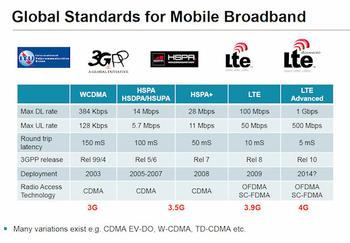LTE and real 4G
But the headline use for these new designs will be in mobile devices, specifically for processing LTE signals. LTE is the next generation mobile communications technology that promises far higher data rates than the current norm.
The first slide below demonstrates where the baseband processor fits into the mix in both phones and wireless dongles, while the second is a handy reference chart for the faster mobile comms technologies.
Note ARM, unlike a lot of mobile operators and handset-makers, doesn't use the term 4G until you get to LTE Advanced, which isn't due for years, and is up to ten-times faster than earlier versions of LTE.
The third slide shows why ARM sees the need for these shiny new Cortex R designs. The Cortex R4 is fine for current technologies, and even LTE category 3, but when you get beyond that you need the R5 and once LTE-A arrives, its Cortex R7 time.
Back to the original, and fundamental, question of why ARM is telling us about this and we're telling you: this launch won't really change how you buy your phone as you probably won't know, or care, what kind of baseband processor is in your phone.
But now you know what kind of data rates you can potentially get from a given mobile technology, and understand that there's many a slip twixt cup and lip, you will be better positioned to understand when your mobile device is taking so long to load a web page or map. It's not always the network's fault.
Incidentally, one of ARM's biggest customers in the baseband processor business - Infineon - has just completed its acquisition by arch ARM rival Intel. It looks like this is at least one area where the two chip companies will have to play nice.









